A couple weeks ago, we chatted about this yellowed and stained piece of linen that I was freshening up and (hopefully) bringing back to white.
Many of you wrote in with some great suggestions for whitening old linens – if you are missed that article and you’re looking for ways to whiten linens, make sure you read the previous article and the comments.
After boiling with cream of tartar, which can be a successful way to remove stains and some types of markings from linen, I plunged into the Buttermilk Adventure detailed in the previous article.
You see, this was an experiment of sorts. I had read about using buttermilk to whiten linens in older books. I just wanted to see how it would work. Curiosity and all…
And guess what? After a 36-hour soak, I conceded that buttermilk doesn’t really work. It made perhaps a mild dent in the yellowing, and it may have lightened the stain a fraction, but not really enough to notice at a glance. So I decided to move on.
I have successfully struck the Buttermilk Soak from my bucket list.
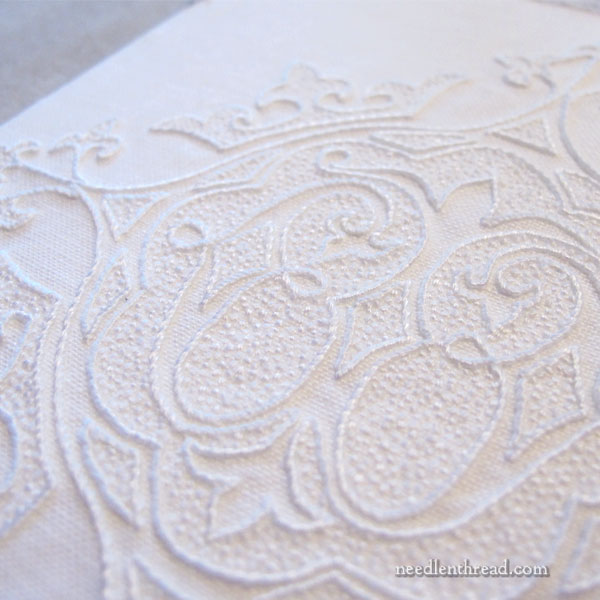
As you can see, though, the linen is back to a decent white, so I’ll tell you how that came about.
And it’s not rocket science, trust me!
After the tasty buttermilk adventure, I moved on to a 24 hour Borax soak. I like Borax for some things.
It helped a little – more than the buttermilk did – but I was not entirely satisfied. And the stain on the back of the linen was still very visible.
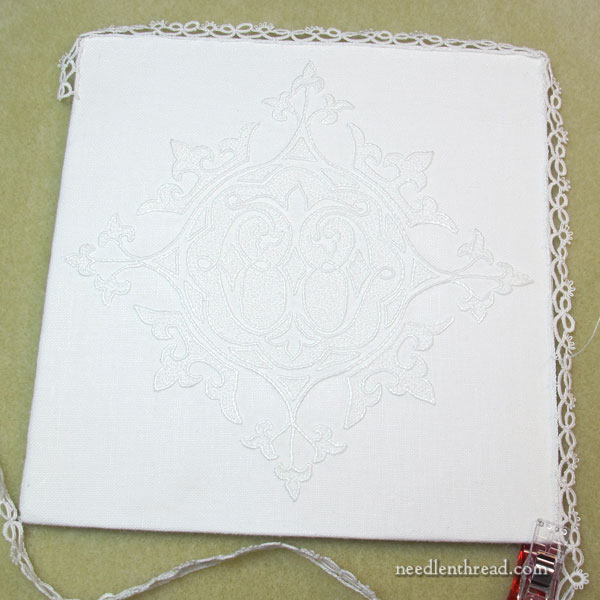
By this time, I figured it was time to cut to the quick. I really didn’t want to spend a whole week going through every type of cleaning option.
So I jumped straight to what I knew would work, and that was OxyClean White Revive. I have both types of OxyClean, but since I was going for white, I just grabbed the White Revive.
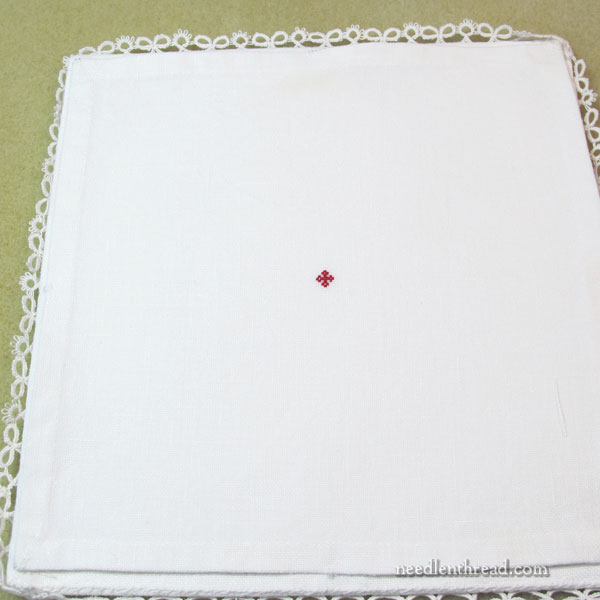
I sprayed the stain down with OxyClean Max Force stain remover.
There’s still a very very faint shadow of the stain, but it’s nothing near what it was:
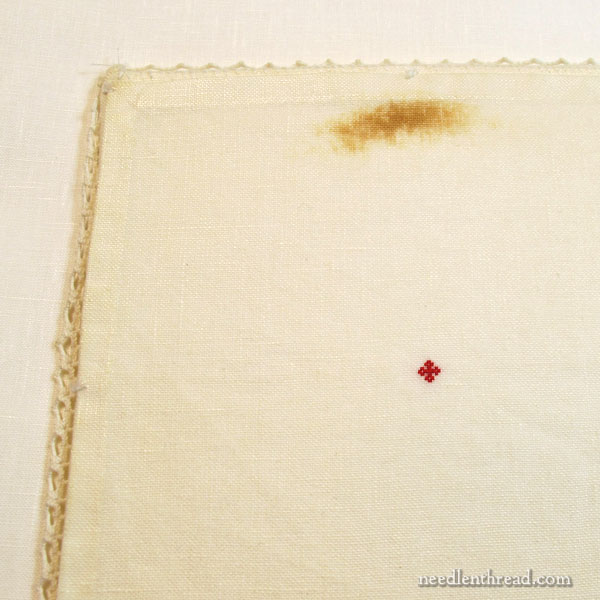
I was pretty satisfied with the stain remover. It’s the first time I used it, and it worked well.
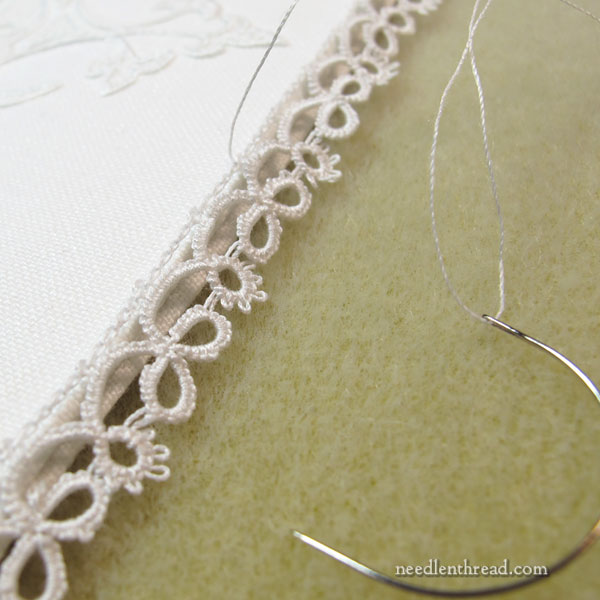
I had to sew new lace on, because I really didn’t want to fiddle with washing and pinning out tiny lace trim. It wasn’t worth it!
For the second trim, I selected a piece of hand tatting that I had on hand. The linen used on this project is a natural white, not an optical white, so I didn’t want to use any new, bright-white lace that would, in effect, make the linen look dingy. The tatting is a natural white as well.
Do Your Research!
I’ve got many, many laundry products for working with textiles! From Orvus, to OxiClean, to Vinegar, to Ivory, to Retro Wash & Retro Clean, to Restoration, to Sodium Percarbonate, to Hydrogen Peroxide, to Borax, to Bleach, and so forth – my laundry cabinet looks like a lab.
Since I initially had time to fool around with it, I wanted to give the buttermilk thing a try. So I gave it a Good Chance. It’s not something I’d bother with again.
Before plunging into cleaning any textile, if you have time, do some research on the type of fabric (what’s it made out of? is it a plant-based fiber? protein-based?) and the type of cleaner, and even the type of water you have. Did you know that some detergents don’t work as well in hard water? Did you know that some detergents can permanently adhere to fabrics, when using the wrong kind of water? And some soaps react certain ways to hard water, too, due to the mineral content. Did you know there’s a difference between soap and detergent? These are things that are kind of fun to research, if you like that sort of thing.
But if that type of reading doesn’t float your boat, here’s my tip: at least carefully read the labels on any soap or detergent that you use. Some work better on plant based fibers (like cotton, flax), and are not recommended for protein based fibers (silk, wool). Pay attention to those types of warnings! OxyClean works great on cotton and linen. It’s not recommended for silk.
Loose Ends!
I love tying up loose ends, and this is another one all tidily tied together. The pall is clean, reassembled, and returned.
There’s still a stack of little (and big) things that I need to catch up on, though. When in situations like this, I pick the smaller projects that I know I can get out of the way quickly, so that they aren’t hanging over my head and so that my time is freed up for tackling larger projects.
Between catching up on a backlog of work and moving forward to keep things going at Needle ‘n Thread, life is very busy!
Towel Sets
You’ll find some ready-to-stitch towel sets all prepared and restocked for you in my shop, if you’re looking for some Autumn designs to stitch (try the Autumn Variety set or the Festive Fall set – or both!). There are also a few Holly & Evergreen ready, if you’re working towards Christmas right now.
I’ll be introducing at least one new Christmas design for the ready-to-stitch towels soon, too. The designs on this set are simple and quick, making them great for gifting!
Books
I’ll be restocking Elisabetta’s A Sea to Stitch very soon. (I reviewed it here.) New books are on their way! I’ll email the Advanced Notice list folks first, so if you are eager for a copy, drop me a line and I’ll put you on the list.







This is great information! I had no idea that certain products worked on plant-based versus protein-based fibers.
I hope you have WD-40 in your laundry bin along with all the others. I’ve learned from another wonderful stitcher about it’s use on grease stains. My husband came home with axle grease on his favorite white shirt. I tried warm water and Dawn detergent (per instructions on the Internet) to no avail. We marched the shirt out to the garage and started spraying WD-40 on the grease spots and rubbed the fabric together. The grease disappeared – completely! I soaked the shirt again in some warm water and a bit of Dawn to get out the smell. Then washed it with other clothes. It’s as good as new!
Thanks for all your research and fun reading!
A few years ago, I was working on a Lenten stole for our pastor – dark purple with while stitching. I couldn’t find the purple fabric I wanted, so I dyed it myself – a henna and silk blend. Well, all went well until I went to wash my work prior to handing it off to the seamstress who was putting it together with the black velvet backing (the better to stick to the pastor’s robe). The purple bled into the white embroidery! I was heartbroken. I researched, and found mostly comments that said either “try Orvus” or “too bad, so sad”. I live in a city, so couldn’t find Orvus, but I did look up why it worked – Polysorbate 20. And I could find that! I now keep a supply of Polysorbate 20 on hand for my most stubborn stains. It’s a whetting agent – it makes water wetter, and helps lift the stain. And, as long as you soak it for 36+ hours, it works.
Just my bit of hard-earned knowledge. Not sure I’d call it wisdom.
Dear Mary
I’m glad you tested the buttermilk and have advised not to use the product when whitening linen, thank you. I prefer the second lace you have used on the Pall, it’s much prettier. Thank you for the tips on the different cleaning products and different types of water, as you say it’s worth researching before delving into whitening or cleaning linen. I’m glad you have finished the Pall and you are catching up with other projects. Thank you for sharing with us your tips and techniques on cleaning textiles it’s really helpful and useful instructions for future reference.
Regards Anita Simmance
Morning Mary
This is just an FYI response, I grew up in an area where the water supply percolated through chalk hills and was therefore extremely hard, the best you could hope for was a scummy layer of suds on the top of the wash water and the tea kettle would lime up so fast you wouldn’t believe, don’t remember how she did it but mum would have to de-lime the kettle every month and scale blocked supply lines was a common problem. Didn’t know what real suds was til I came out to the states.
In our area of the PNW the water percolates through iron and manganese laden soil. You’ll never get anything white if you use bleach as the bleach oxidizes the iron rapidly which then falls out of suspension and stains everything it comes in contact with, a non-perborated bleach such as Borax works better with such water.
When laundering fine linens I’d also be using distilled water to avoid the above mentioned problems even if it means buying by the gallon.
Thanks for keeping us so well informed Mary and describing what works and what doesn’t along with the why’s and wherefore’s.
Brenda
Any chance you could provide transfers rather than transfers-on-flour-sack-towels? 🙂 I love the designs, have challenges in making transfers, but don’t like flour sack towels at ALL, not the size, not the cloth, not the end use. I’d rather embroider a table runner or handkerchief or a pocket for a tote bag or something like that, if I had the transfers to use…
Thanks for considering this!
Holly
I am very interested in A Sea to Stitch and would love to be on the list. I love your blog and have learned so vet much.
Thank you.
Hi, Debi – Can you drop me a line at mary(at)needlenthread(dot)com to be placed on the advanced notice list? Thanks!
Thank you for all your valuable information. Can you please put me on the list for A Sea to Stitch book?
Thank you so much
Debi
Hi, Debi – can you drop me an email, so I can add you to the email list? Thanks!!
Mary, I can understand wanting to try buttermilk even if it leaves you will a sour-smelling mess. Wouldn’t it have been fun if it worked. Actually though I was wondering why you didn’t try Orvus/Quilters Soap. There’s this really nice lady named Mary who writes an excellent needlework website, and she turned me on to this product. It’s safe and it works.
LOL! It works for some things, but not others. Over the years, I’ve learned a bit about Orvus – it’s worth doing a little research. It’s often touted as perfectly harmless, as excellent for conservation (of any textiles) – but there are exceptions!! Worth researching!
About the hand tatted edging – is it tatted/sewn onto a crocheted base? I love the look of your finished pall. Just beautiful!
It’s on a very simple, tiny, chain stitch line.
I appreciate your article and have a question. I have some flour sacks that have set in my closet for several years. I think they were washed before they were given to me. I pulled them out this week to use for a specific project. A few of them have yellowing stains along the edges and some darker stains toward the middle of the fabric. Would you suggest the oxy revive to remove the stains and would it damage the material to soak them in biz?
I would try either – biz or oxyclean. They both work on cotton.
We are the Diocesan Altar Guild , serving Episcopal churches in Western Washington State. We often use lemon juice and salt sprinkled on wet linen,
lay in the sun, re-moisten as many times as deemed necessary.( this will even
reduce or remove rust stains from old pins, etc) Do not iron until the stain is
gone.Even a bright window area has enough light for the chemistry to work.
If fabric has a wine stain, moisten the spot with Wine Away, by Evergreen Labs, Inc., available in many grocery stores in the laundry section. Allow to soak in tepid water for an hour or so, add boiling water and a drop of dish soap to swish a while. Rinse well with lemon juice in the 1st rinse, and lay in
the sun to dry. Most stains will fade out. (worst stain took a week of sunlight to reduce)
A century ago, women put their finer linens on the lawn, if available, and
left them all day to dry. Some green-leaf bushes were a second choice. The
wet linen reacts with the chlorophyll as the sun warms the lawn or bush.
This technique has been tried with great success for even large altar linens
that were deemed un-useable! The best sequence was, a “Fels” soak, lemon rinse, out onto the lawn in the evening to get the most am sun, Flip for a 2nd
day, hand wash in the sink or tub, hang in the sun until damp, iron while wet.
Chlorox was a new product n the early 1900’s. It may have eliminated the stains faster, but does damage to the fabric. Oxy-clean has causes Many
to come crying to us for help…the worst result looked like a mouse had eaten
all over the expensive linen. Other conditions appear to be like ‘felting’.
Hope this might expand the approaches on fabric care and stain removal.
Sherry K. Garman
Directress
Diocesan Altar Guild
Diocese of Olympia
A third very reliable stain removal product is Fels-Naptha, (bar soap) Again, soak in tepid water with ‘Fels’ rubbed onto the spots for about an hour. Add boiling water and swish awhile; if spot persists, repeat the soaking process again. Our workspace has a nice counter in a sunny window. We also have plexiglass in various sizes to spread wet linens on for drying in the sunny windows. When spread smoothly, almost no ironing is necessary
Older tradition used to say “pour boiling water on a stain”, or “Boil it”.
The technicians say that hot water actually sets the stain harder into the
fabric fibers; soaking in cool or tepid water allows the stain elements to
break down instead.
I have an embroidered linen Ukrainian blouse that has yellowed over time. The embroidery is burgundy and navy. Can you recommend a whitening process that will not ruin the embroidery? Will the oxyclean work? Many thanks.
Gosh, that’s always a tricky one. I would say test whatever you’re going to use on an inconspicuous spot, and don’t use anything warmer than lukewarm water. Oxyclean might work, but it really depends on what the thread is made from. If it’s cotton, I could be fine (but I wouldn’t want it to fade – I think they make an Oxyclean for colors?) but if the thread is silk, don’t use any Oxy product.
Test test test!!